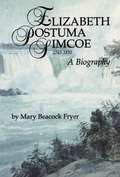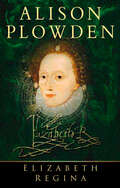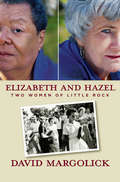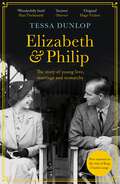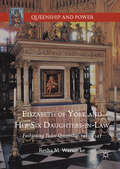- Table View
- List View
Elizabeth Patterson Bonaparte
by Charlene M. Boyer LewisTwo centuries ago, Elizabeth Patterson Bonaparte was one of the most famous women in America. Beautiful, scandalous, and outspoken, she had wed Napoleon's brother Jerome, borne his child, and seen the marriage annulled by the emperor himself. With her notorious behavior, dashing husband, and associations with European royalty, Elizabeth became one of America's first celebrities during a crucial moment in the nation's history. At the time of Elizabeth's fame, the United States had only recently gained its independence, and the character of American society and politics was not yet fully formed. Still concerned that their republican experiment might fail and that their society might become too much like that of monarchical Europe, many Americans feared the corrupting influence of European manners and ideas. Elizabeth Patterson Bonaparte's imperial connections and aristocratic aspirations made her a central figure in these debates, with many, including members of Congress and the social elites of the day, regarding her as a threat.Appraising Elizabeth Patterson Bonaparte's many identities--celebrity, aristocrat, independent woman, mother--Charlene M. Boyer Lewis shows how Madame Bonaparte, as she was known, exercised extraordinary social power at the center of the changing transatlantic world. In spite of the assumed threat that she posed to the new social and political order, Americans could not help being captivated by Elizabeth's style, beauty, and wit. She offered an alternative to the republican wife by pursuing a life of aristocratic dreams in the United States and Europe. Her story reminds us of the fragility of the American experiment in its infancy and, equally important, of the active role of women in the debates over society and culture in the early republic.
Elizabeth Posthuma Simcoe 1762-1850: A Biography
by Mary Beacock FryerThe diaries, letters, and sketches of Elizabeth Simcoe are drawn upon as sources in this portrayal of the energetic and remarkable woman who came to Upper Canada with her husband when he was appointed lieutenant governor.
Elizabeth Regina
by Alison PlowdenBiography of the life and reign of Elizabeth I of England, who ruled for 45 years from 1558.
Elizabeth Robins: 1862-1952
by Angela V. John Prof Angela JohnA woman of extraordinary energy, talent and versatility. Elizabeth Robins was an actress who popularised Ibsen on the British stage, a prolific and popular writer of novels and non-fiction, and an Edwardian suffragette. Her extensive circle of friends included Florence Bell, Henry James, John Masefield and William Archer. She worked with the Pankhursts and knew the Woolfs. Through examining the life and work of this vivid and transatlantic figure born during the American Civil War yet surviving into the England of the 1950s, Angela John raises questions about the shaping of historical identities. Situating Elizabeth Robins's achievement in the context of the British and American cultural history of the period, this is a book which will attract historians, teachers and students of theatre studies and all those fascinated by biography.
Elizabeth Seton: American Saint
by Catherine O'DonnellIn 1975, two centuries after her birth, Pope Paul VI canonized Elizabeth Ann Seton, making her the first saint to be a native-born citizen of the United States in the Roman Catholic Church. Seton came of age in Manhattan as the city and her family struggled to rebuild themselves after the Revolution, explored both contemporary philosophy and Christianity, converted to Catholicism from her native Episcopalian faith, and built the St. Joseph’s Academy and Free School in Emmitsburg, Maryland. Hers was an exemplary early American life of struggle, ambition, questioning, and faith, and in this flowing biography, Catherine O’Donnell has given Seton her due.O’Donnell places Seton squarely in the context of the dynamic and risky years of the American and French Revolutions and their aftermath. Just as Seton’s dramatic life was studded with hardship, achievement, and grief so were the social, economic, political, and religious scenes of the Early American Republic in which she lived. O’Donnell provides the reader with a strong sense of this remarkable woman’s intelligence and compassion as she withstood her husband’s financial failures and untimely death, undertook a slow conversion to Catholicism, and struggled to reconcile her single-minded faith with her respect for others’ different choices. The fruit of her labors were the creation of a spirituality that embraced human connections as well as divine love and the American Sisters of Charity, part of an enduring global community with a specific apostolate for teaching.The trove of correspondence, journals, reflections, and community records that O’Donnell weaves together throughout Elizabeth Seton provides deep insight into her life and her world. Each source enriches our understanding of women’s friendships and choices, illuminates the relationships within the often-opaque world of early religious communities, and upends conventional wisdom about the ways Americans of different faiths competed and collaborated during the nation’s earliest years. Through her close and sympathetic reading of Seton’s letters and journals, O’Donnell reveals Seton the person and shows us how, with both pride and humility, she came to understand her own importance as Mother Seton in the years before her death in 1821.
Elizabeth Started All the Trouble
by Doreen RappaportShe couldn't go to college. She couldn't become a politician. She couldn't even vote. But Elizabeth Cady Stanton didn't let that stop her. She called on women across the nation to stand together and demand to be treated as equal to men-and that included the right to vote. It took nearly seventy-five years and generations of women fighting for their rights through words, through action, and through pure determination . . . for things to slowly begin to change. With the help of these trailblazers' own words, Doreen Rappaport's engaging text, brought to life by Matt Faulkner's vibrant illustrations, shows readers just how far this revolution has come, and inspires them to keep it going!
Elizabeth Taylor: The Grit & Glamour of an Icon
by Kate Andersen BrowerFrom the #1 New York Times bestselling author of The Residence and First Women, the first ever authorized biography of the most famous movie star of the twentieth century, Elizabeth Taylor.No celebrity rivals Elizabeth Taylor’s glamour and guts or her level of fame. She was the last major star to come out of the old Hollywood studio system and she is a legend known for her beauty and her magnetic screen presence in a career that spanned most of the twentieth century and nearly sixty films. But her private life was even more compelling than her Oscar-winning on-screen performances. During her seventy-nine years of rapid-fire love and loss she was married eight times to seven different men. Above all, she was a survivor—by the time she was twenty-six she was twice divorced and once widowed. Her life was a soap opera that ended in a deeply meaningful way when she became the first major celebrity activist to lead the fight against HIV/AIDS. A co-founder of amfAR, she raised more than $100 million for research and patient care. She was also a shrewd businesswoman who made a fortune as the first celebrity perfumer who always demanded to be paid what she was worth.In the first ever authorized biography of the Hollywood icon, Kate Andersen Brower reveals the world through Elizabeth’s eyes. Brower uses Elizabeth’s unpublished letters, diary entries, and off-the-record interview transcripts as well as interviews with 250 of her closest friends and family to tell the full, unvarnished story of her remarkable career and her explosive private life that made headlines worldwide. Elizabeth Taylor captures this intelligent, empathetic, tenacious, volatile, and complex woman as never before, from her rise to massive fame at age twelve in National Velvet to becoming the first to negotiate a million-dollar salary for a film, from her eight marriages and enduring love affair with Richard Burton to her lifelong battle with addiction and her courageous efforts as an AIDS activist. Here is a fascinating and complete portrait worthy of the legendary star and her legacy.Elizabeth Taylor features a photo insert.
Elizabeth Widville, Lady Grey: Edward IV's Chief Mistress and the 'Pink Queen'
by John Ashdown-HillThe author of The Mythology of the &“Princes in the Tower&” separates fact from fiction in this biography of an influential former queen of England. Wife to Edward IV and mother to the Princes in the Tower and later Queen Elizabeth of York, Elizabeth Widville was a central figure during the War of the Roses. Much of her life is shrouded in speculation and myth—even her name, commonly spelled &“Woodville,&” is a hotly contested issue. In this fascinating and insightful biography, Dr. John Ashdown-Hill sheds light on the truth of her life. Born in the turbulent fifteenth century, she was famed for her beauty and controversial second marriage to Edward IV, who she married just three years after he had displaced the Lancastrian Henry VI and claimed the English throne. As Queen Consort, Elizabeth&’s rise from commoner to royalty continues to capture modern imagination. Undoubtedly, it enriched the position of her family. Her elevated position and influence invoked hostility from Richard Neville, the &“Kingmaker,&” which later led to open discord and rebellion. Throughout her life and even after the death of her husband, Elizabeth remained politically influential: briefly proclaiming her son King Edward V of England before he was deposed by her brother-in-law, the infamous Richard III, she would later play an important role in securing the succession of Henry Tudor in 1485 and his marriage to her daughter Elizabeth of York, thus and ending the War of the Roses. An endlessly enigmatic, historical figure, Elizabeth Widville has been obscured by dramatizations and misconceptions. In Elizabeth Widville, Lady Grey, Ashdown-Hill attempts to set the record straight.
Elizabeth Woodville: Mother of the Princes in the Tower
by David BaldwinElizabeth Woodville is undoubtedly a historical character whose life no novelist would ever have dared invent. She has been portrayed as an enchantress; as an unprincipled advancer of her family's fortunes and a plucky but pitiful queen in Shakespeare's histories. She has been alternatively championed and vilified by her contemporaries and five centuries of historians, dramatists and novelists, but what was she really like? In this revealing account of Elizabeth's life David Baldwin sets out to tell the story of this complex and intriguing woman. Was she the malign influence many of her critics held her to be? Was she a sorceress who bewitched Edward IV? What was the fate of her two sons, the 'Princes in the Tower'? What did she, of all people, think had become of them, and why did Richard III mount a campaign of vilification against her? David Baldwin traces Elizabeth's career and her influence on the major events of her husband Edward IV's reign, and in doing so he brings to life the personal and domestic politics of Yorkist England and the elaborate ritual of court life.
Elizabeth and Hazel: Two Women of Little Rock
by David MargolickThe names Elizabeth Eckford and Hazel Bryan Massery may not be well known, but the image of them from September 1957 surely is: a black high school girl, dressed in white, walking stoically in front of Little Rock Central High School, and a white girl standing directly behind her, face twisted in hate, screaming racial epithets. This famous photograph captures the full anguish of desegregation--in Little Rock and throughout the South--and an epic moment in the civil rights movement. In this gripping book, David Margolick tells the remarkable story of two separate lives unexpectedly braided together. He explores how the haunting picture of Elizabeth and Hazel came to be taken, its significance in the wider world, and why, for the next half-century, neither woman has ever escaped from its long shadow. He recounts Elizabeth's struggle to overcome the trauma of her hate-filled school experience, and Hazel's long efforts to atone for a fateful, horrible mistake. The book follows the painful journey of the two as they progress from apology to forgiveness to reconciliation and, amazingly, to friendship. This friendship foundered, then collapsed--perhaps inevitably--over the same fissures and misunderstandings that continue to permeate American race relations more than half a century after the unforgettable photograph at Little Rock. And yet, as Margolick explains, a bond between Elizabeth and Hazel, silent but complex, endures.
Elizabeth and Leicester
by Sarah GristwoodFew relationships fire our imagination like that of Elizabeth I and her 'bonnie sweet Robin' - The Earl of Leicester, Robert dudley. But it has been almost half a century since any book set out specifically to examine and disentangle the emotive, often contradictory facts about their lifelong love. They met - it's alleged - when both were imprisoned in the Tower of London. Soon after Elizabeth was queen came the scandalised letters from ambassadors of her infatuation with the married Robert Dudley - to be followed a mere two years later by the suspicious death of his wife Amy. Speculation ran for years that Elizabeth an Robert in their turn would marry. Instead, they developed a working partnership, and - an even more extraordinary intimacy - a bond of mutual dependence and affection. By the time Robert died he had been her councillor and commander of her army, sat by her bed in sickness and represented her on state occasions. But she had also humiliated him, made him dance attendance on her other suitors and tried to have him clapped in prison when finally he broke loose and married again. Riven by uncertainties, fuelled by scandal and intrigue, the relationship between a reigning queen and the most hated man in England could never be an easy one. Elizabeth and Leicester is a portrait - at times a startlingly intimate one - of an affair between two people at a crucial moment in history; of a relationship where, very unusually, a woman held all the power; of a love that transcended the centuries, and still speaks to us today.
Elizabeth and Mary: Cousins, Rivals, Queens
by Jane DunnTheir enemies branded them both murderesses, whores and daughters of the devil. Elizabeth’s supporters anointed her a hero and savior, while Mary’s faithful invested her as a saint and martyr. Reigning side by side, but yet never meeting face-to-face, these queens were inexorably linked in a tumultuous relationship that, until now, has never fully been revealed and explored.Elizabeth & Mary: Cousins, Rivals, Queens is master biographer Jane Dunn’s richly textured portrait of two incredible women. A story of a relationship punctuated by reversals of fortune; murder mysteries; sexual intrigue; reckless behavior, heated battles and cold war, Elizabeth & Mary is staged against a past as dark and dangerous as it was vibrantly alive.Dunn shows the indissoluble bond between the queens was forged by two opposing forces; their shared inheritance and rivalry for Elizabeth’s crown set against their natural solidarity as ruling females in an overwhelmingly masculine world. She delves behind Elizabeth’s reputation as steely virgin queen, using her celibacy as a weapon, valuing reason and duty above all. She looks at Mary as celebrity queen, femme fatale and flawed heroine, a woman who capped the theatre of her death in a brilliant cloak of redemption. And she corrects many misconceptions about her subjects, revealing Mary as a more serious contender for power than had been previously thought, and Elizabeth as far more vulnerable than her formidable reputation.Intelligent and completely riveting, this beautifully produced and lavishly illustrated book masterfully juxtaposes the histories of two remarkable women, culminating in tragedy, as Elizabeth the victor—hesitantly—signed her cousin’s death warrant.
Elizabeth and Mary: Cousins, Rivals, Queens
by Jane DunnThe first dual biography of two of the world’s most remarkable women—Elizabeth I of England and Mary Queen of Scots—by one of Britain’s “best biographers” (The Sunday Times). In a rich and riveting narrative, Jane Dunn reveals the extraordinary rivalry between the regal cousins. It is the story of two queens ruling on one island, each with a claim to the throne of England, each embodying dramatically opposing qualities of character, ideals of womanliness (and views of sexuality) and divinely ordained kingship. As regnant queens in an overwhelmingly masculine world, they were deplored for their femaleness, compared unfavorably with each other and courted by the same men. By placing their dynamic and ever-changing relationship at the center of the book, Dunn illuminates their differences. Elizabeth, inheriting a weak, divided country coveted by all the Catholic monarchs of Europe, is revolutionary in her insistence on ruling alone and inspired in her use of celibacy as a political tool—yet also possessed of a deeply feeling nature. Mary is not the romantic victim of history but a courageous adventurer with a reckless heart and a magnetic influence over men and women alike. Vengeful against her enemies and the more ruthless of the two queens, she is untroubled by plotting Elizabeth’s murder. Elizabeth, however, is driven to anguish at finally having to sanction Mary’s death for treason. Working almost exclusively from contemporary letters and writings, Dunn explores their symbiotic, though never face-to-face, relationship and the power struggle that raged between them. A story of sex, power and politics, of a rivalry unparalleled in the pages of English history, of two charismatic women—told in a masterful double biography. From the Hardcover edition.
Elizabeth and Philip: A Story of Young Love, Marriage and Monarchy
by Tessa DunlopShe was peaches-and-cream innocence; he was a handsome war hero. Both had royal blood coursing through their veins. The marriage of Britain's Princess Elizabeth to Lt Philip Mountbatten in November 1947 is remembered as the beginning of an extraordinary, lifelong union but success was not guaranteed. Elizabeth and Philip: A Story of Young Love, Marriage and Monarchy plunges us back into 1940s Britain where a teenage Princess fell in love with a foreign Prince. Cue fears of a flirtatious 'Greek' fortune hunter stealing off with England's crown jewel and subsequent efforts by the Establishment to reframe Philip as the perfect fit for Britain's most famous family.Drawing on original newspaper archives and the opinions of Elizabeth and Philip's contemporaries still alive today, historian Dr Tessa Dunlop discovers a post-war world on the cusp of major change. Unprecedented polling on Philip's suitability was a harbinger of pressures to come for a couple whose marriage was branded the ultimate global fairytale. Theirs was a partnership like no other. Six years after Elizabeth promised to be an obedient wife Philip got down on bended knee and committed himself as the Queen's 'liege man of life and limb.'Published to coincide with the 75th anniversary of their marriage, this deeply touching history explores the ups and downs, the attraction and the tensions that defined an extraordinary relationship. The high stakes involved might have devoured a less committed pair - but not Elizabeth and Philip. They shared a common purpose, one higher even than marriage, with roots much deeper than young love. Happy and Glorious, for better or for worse, they were heavily invested in a God-given mission. Monarchy was the magic word.(P) 2022 Headline Publishing Group Ltd
Elizabeth and Philip: A Story of Young Love, Marriage and Monarchy
by Tessa DunlopShe was 'sugar pink' innocence; he was a handsome war hero. Both had royal blood coursing through their veins. The marriage of Britain's Princess Elizabeth to Lieutenant Philip Mountbatten in November 1947 is remembered as the beginning of an extraordinary, lifelong union but success was not guaranteed. Elizabeth and Philip: A Story of Young Love, Marriage and Monarchy plunges us back into the 1940s when a teenage princess fell in love with a foreign prince. Cue fears of a flirtatious 'Greek' fortune hunter stealing off with Britain's crown jewel and Philip's supporters scrambling to reframe him as a good fit for the Royal Family. Drawing on original newspaper archives and the opinions of Elizabeth and Philip's contemporaries, historian Dr Tessa Dunlop discovers a post-war world on the cusp of major change. Unprecedented polling on Philip's suitability was a harbinger of pressures to come for a couple whose marriage was branded the ultimate global fairytale. Theirs was a partnership like no other. Six years after Elizabeth promised to be an obedient wife Philip got down on bended knee at the coronation and committed himself as the Queen's 'liege man of life and limb.' Published 75 years after their marriage, this deeply touching history explores the ups and downs, the public appeal and the private tensions that defined an extraordinary relationship. The high stakes involved might have devoured a less committed pair - but Elizabeth and Philip shared a common purpose, one higher even than marriage, with roots much deeper than young love. Happy and Glorious, for better or for worse, how did their union succeed? Monarchy was the magic word.
Elizabeth and Philip: A Story of Young Love, Marriage and Monarchy
by Tessa DunlopShe was 'sugar pink' innocence; he was a handsome war hero. Both had royal blood coursing through their veins. The marriage of Britain's Princess Elizabeth to Lieutenant Philip Mountbatten in November 1947 is remembered as the beginning of an extraordinary, lifelong union but success was not guaranteed. Elizabeth and Philip: A Story of Young Love, Marriage and Monarchy plunges us back into the 1940s when a teenage princess fell in love with a foreign prince. Cue fears of a flirtatious 'Greek' fortune hunter stealing off with Britain's crown jewel and Philip's supporters scrambling to reframe him as a good fit for the Royal Family. Drawing on original newspaper archives and the opinions of Elizabeth and Philip's contemporaries, historian Dr Tessa Dunlop discovers a post-war world on the cusp of major change. Unprecedented polling on Philip's suitability was a harbinger of pressures to come for a couple whose marriage was branded the ultimate global fairytale. Theirs was a partnership like no other. Six years after Elizabeth promised to be an obedient wife Philip got down on bended knee at the coronation and committed himself as the Queen's 'liege man of life and limb.' Published 75 years after their marriage, this deeply touching history explores the ups and downs, the public appeal and the private tensions that defined an extraordinary relationship. The high stakes involved might have devoured a less committed pair - but Elizabeth and Philip shared a common purpose, one higher even than marriage, with roots much deeper than young love. Happy and Glorious, for better or for worse, how did their union succeed? Monarchy was the magic word.
Elizabeth of York and Her Six Daughters-in-Law
by Retha M. WarnickeThis study of early modern queenship compares the reign of Henry VII's queen, Elizabeth of York, and those of her daughters-in-law, the six queens of Henry VIII. It defines the traditional expectations for effective Tudor queens--particularly the queen's critical function of producing an heir--and evaluates them within that framework, before moving to consider their other contributions to the well-being of the court. This fresh comparative approach emphasizes spheres of influence rather than chronology, finding surprising juxtapositions between the various queens' experiences as mothers, diplomats, participants in secular and religious rituals, domestic managers, and more. More than a series of biographies of individual queens, Elizabeth of York and Her Six Daughters-in-Law is a careful, illuminating examination of the nature of Tudor queenship.
Elizabeth of York: A Tudor Queen and Her World
by Alison WeirMany are familiar with the story of the much-married King Henry VIII of England and the celebrated reign of his daughter, Elizabeth I. But it is often forgotten that the life of the first Tudor queen, Elizabeth of York, Henry's mother and Elizabeth's grandmother, spanned one of England's most dramatic and perilous periods. Now New York Times bestselling author and acclaimed historian Alison Weir presents the first modern biography of this extraordinary woman, whose very existence united the realm and ensured the survival of the Plantagenet bloodline. Her birth was greeted with as much pomp and ceremony as that of a male heir. The first child of King Edward IV, Elizabeth enjoyed all the glittering trappings of royalty. But after the death of her father; the disappearance and probable murder of her brothers--the Princes in the Tower; and the usurpation of the throne by her calculating uncle Richard III, Elizabeth found her world turned upside-down: She and her siblings were declared bastards. As Richard's wife, Anne Neville, was dying, there were murmurs that the king sought to marry his niece Elizabeth, knowing that most people believed her to be England's rightful queen. Weir addresses Elizabeth's possible role in this and her covert support for Henry Tudor, the exiled pretender who defeated Richard at the Battle of Bosworth and was crowned Henry VII, first sovereign of the House of Tudor. Elizabeth's subsequent marriage to Henry united the houses of York and Lancaster and signaled the end of the Wars of the Roses. For centuries historians have asserted that, as queen, she was kept under Henry's firm grasp, but Weir shows that Elizabeth proved to be a model consort--pious and generous--who enjoyed the confidence of her husband, exerted a tangible and beneficial influence, and was revered by her son, the future King Henry VIII. Drawing from a rich trove of historical records, Weir gives a long overdue and much-deserved look at this unforgettable princess whose line descends to today's British monarch--a woman who overcame tragedy and danger to become one of England's most beloved consorts. Praise for Alison Weir's Mary Boleyn, named one of the Best Books of the Year by The Chicago Tribune "This nuanced, smart, and assertive biography reclaims the life of a Tudor matriarch."--Publishers Weekly "Weir has achieved the enviable skill of blending the necessary forensic and analytical tasks of academia with the passionate engagement that avocational history lovers crave."--Bookreporter "Top-notch . . . This book further proves that [Weir] is a historian of the highest caliber."--Washington Independent Review of Books "A refreshing change from recent books on the subject . . . If you want to learn more about this often-maligned woman of the sixteenth century, this is a must-read."--The Free Lance-Star "Weir's research is always first-rate and her narratives accessible. In her latest book, the author has to navigate the historical minefields of gossip, fiction, and conjecture to finally get at the truth."--Tucson Citizen "Engaging . . . Weir matches her usual professional skills in research and interpretation to her customary, felicitous style."--Booklist
Elizabeth of York: Tudor Rose Novel 1
by Alison WeirYou've read Alison Weir's bestselling Six Tudor Queens. This is her captivating new novel. 'Alison Weir gives us her most compelling heroine yet... This is where the story of the Tudors begins and is historical fiction at its absolute best' TRACY BORMAN'One of the great women of history... History has the best stories and they should all be told like this' CONN IGGULDEN--- Mother. Survivor. Queen. ---AN ENGLISH PRINCESS, BORN INTO A WAR BETWEEN TWO FAMILIES.Eldest daughter of the royal House of York, Elizabeth dreams of a crown to call her own. But when her beloved father, King Edward, dies suddenly, her destiny is rewritten.Her family's enemies close in. Two young princes are murdered in the Tower. Then her uncle seizes power - and vows to make Elizabeth his queen.But another claimant seeks the throne, the upstart son of the rival royal House of Lancaster. Marriage to this Henry Tudor would unite the white rose of York and the red of Lancaster - and change everything.A great new age awaits. Now Elizabeth must choose her allies - and husband - wisely, and fight for her right to rule. ---PRAISE FOR THE SIX TUDOR QUEENS SERIES:'This series is a serious achievement' The Times'Weir is excellent on the little details that bring a world to life' Guardian'This brilliant series has brought Henry VIII's six wives to life as never before' Tracy Borman 'Profoundly moving... lingers long after the last page' Elizabeth Fremantle'Well researched and engrossing' Good Housekeeping'Vivid characters and a wonderful sense of time and place' Barbara Erskine'Hugely enjoyable . . . Alison Weir knows her subject and has a knack for the telling and textural detail' Daily Mail
Elizabeth of York: Tudor Rose Novel 1
by Alison WeirBrand-new historical fiction from the author of the Sunday Times-bestselling Six Tudor Queens series. This is the spellbinding, untold story of Elizabeth of York, the first Tudor queen.'Alison Weir gives us her most compelling heroine yet... This is where the story of the Tudors begins and is historical fiction at its absolute best' TRACY BORMAN'One of the great women of history... History has the best stories and they should all be told like this' CONN IGGULDEN--- Mother. Survivor. Queen. ---AN ENGLISH PRINCESS, BORN INTO A WAR BETWEEN TWO FAMILIES.Eldest daughter of the royal House of York, Elizabeth dreams of a crown to call her own. But when her beloved father, King Edward, dies suddenly, her destiny is rewritten.Her family's enemies close in. Two young princes are murdered in the Tower. Then her uncle seizes power - and vows to make Elizabeth his queen.But another claimant seeks the throne, the upstart son of the rival royal House of Lancaster. Marriage to this Henry Tudor would unite the white rose of York and the red of Lancaster - and change everything.A great new age awaits. Now Elizabeth must choose her allies - and husband - wisely, and fight for her right to rule. ---PRAISE FOR THE SIX TUDOR QUEENS SERIES:'This series is a serious achievement' The Times'Weir is excellent on the little details that bring a world to life' Guardian'This brilliant series has brought Henry VIII's six wives to life as never before' Tracy Borman 'Profoundly moving... lingers long after the last page' Elizabeth Fremantle'Well researched and engrossing' Good Housekeeping'Vivid characters and a wonderful sense of time and place' Barbara Erskine'Hugely enjoyable . . . Alison Weir knows her subject and has a knack for the telling and textural detail' Daily Mail(P) 2022 Headline Publishing Group Ltd
Elizabeth of York: Tudor Rose Novel 1
by Alison WeirThe captivating new Tudor novel from Alison Weir, Sunday Times bestselling author of Six Tudor Queens.'Alison Weir gives us her most compelling heroine yet... This is where the story of the Tudors begins' Tracy Borman'History has the best stories and they should all be told like this' Conn Iggulden'A stunning read, and the perfect piece of historical fiction' Reader review ⭐ ⭐⭐ ⭐⭐'This novel captured my imagination, educated me and emotionally moved me' Reader review ⭐ ⭐⭐ ⭐⭐---A princess born into a war between two families...Firstborn of the royal House of York, Elizabeth dreams of wearing a crown. But in England, queens do not rule.When her beloved father, King Edward, dies suddenly, his brother seizes power. Two young princes disappear into the Tower. Yet another claimant seeks the crown, the upstart heir of the rival House of Lancaster. Marriage to this Henry Tudor would unite their warring families - and help Elizabeth to the throne she knows is hers by right.A glorious new age awaits. Now Elizabeth must choose her allies wisely as she fights to become mother and queen of a great new dynasty.Elizabeth of York.The first Tudor queen.Her story.---READERS FELL IN LOVE WITH ELIZABETH OF YORK...'I found her an inspirational woman, full of strength...I truly adored this book''She becomes the matriarch of the Tudor destiny after a series of intrigue, conflict, and most likely murder... a brilliant read''Alison Weir's writing just makes history that bit more exciting and accessible''It was refreshing to read such a detailed and informative book of an almost forgotten Queen''An amazing read as expected from Alison Weir, she breathes life into Elizabeth and those around her'
Elizabeth the Beloved
by Maureen PetersFrom earliest childhood, Elizabeth Plantagenet's life was interwoven with the destinies of three kings: Edward IV her father, whose lechery left her destitute, Richard III, her uncle, whose kindness turned to passion, and Henry VII, her husband, who used her as a shield against his enemies. Surrounded by her loving family and a peaceful court, Elizabeth of York seemed content as England's first Tudor queen. But beneath this serenity she hid an aching loneliness and a heart that had broken on Bosworth Field.
Elizabeth the Queen: The Life of a Modern Monarch
by Sally Bedell SmithIn this magisterial new biography, New York Times bestselling author Sally Bedell Smith brings to life one of the world's most fascinating and enigmatic women: Queen Elizabeth II. From the moment of her ascension to the throne in 1952 at the age of twenty-five, Queen Elizabeth II has been the object of unparalleled scrutiny. But through the fog of glamour and gossip, how well do we really know the world's most famous monarch? Drawing on numerous interviews and never-before-revealed documents, acclaimed biographer Sally Bedell Smith pulls back the curtain to show in intimate detail the public and private lives of Queen Elizabeth II, who has led her country and Commonwealth through the wars and upheavals of the last sixty years with unparalleled composure, intelligence, and grace. In Elizabeth the Queen, we meet the young girl who suddenly becomes "heiress presumptive" when her uncle abdicates the throne. We meet the thirteen-year-old Lilibet as she falls in love with a young navy cadet named Philip and becomes determined to marry him, even though her parents prefer wealthier English aristocrats. We see the teenage Lilibet repairing army trucks during World War II and standing with Winston Churchill on the balcony of Buckingham Palace on V-E Day. We see the young Queen struggling to balance the demands of her job with her role as the mother of two young children. Sally Bedell Smith brings us inside the palace doors and into the Queen's daily routines--the "red boxes" of documents she reviews each day, the weekly meetings she has had with twelve prime ministers, her physically demanding tours abroad, and the constant scrutiny of the press--as well as her personal relationships: with Prince Philip, her husband of sixty-four years and the love of her life; her children and their often-disastrous marriages; her grandchildren and friends. Compulsively readable and scrupulously researched, Elizabeth the Queen is a close-up view of a woman we've known only from a distance, illuminating the lively personality, sense of humor, and canny intelligence with which she meets the most demanding work and family obligations. It is also a fascinating window into life at the center of the last great monarchy.
Elizabeth's London: Everyday Life In Elizabethan London
by Liza PicardThe everyday realities and practical details of daily life in Elizabethan London, which most history books ignore - a Sunday Times bestseller.Like its acclaimed predecessors, RESTORATION LONDON and DR JOHNSON'S LONDON, this book is the result of the author's passionate interest in the practical details of everyday life - and the conditions in which most people lived - so often ignored in conventional history books. The book begins with the River Thames, which - from its surly water-men to its great occasions - played such a central part in the city's life. It moves on to the streets, houses and gardens; cooking, housework and shopping; clothes, jewellery and make-up; health and medicine; sex and food; education, etiquette and hobbies; religion, law and crime.
Elizabeth's London: Everyday Life in Elizabethan London (Life of London #1)
by Liza Picard'Reading this book is like taking a ride on a marvellously exhilarating time-machine, alive with colour, surprise and sheer merriment' Jan MorrisElizabethan London reveals the practical details of everyday life so often ignored in conventional history books. It begins with the River Thames, the lifeblood of Elizabethan London, before turning to the streets and the traffic in them. Liza Picard surveys building methods and shows us the interior decor of the rich and the not-so-rich, and what they were likely to be growing in their gardens. Then the Londoners of the time take the stage, in all their amazing finery. Plague, smallpox and other diseases afflicted them. But food and drink, sex and marriage and family life provided comfort. Cares could be forgotten in a playhouse or the bull-baiting of bear-baiting rings, or watching a good cockfight. Liza Picard's wonderfully skilful and vivid evocation of the London of Elizabeth I enables us to share the delights, as well as the horrors, of the everyday lives of our sixteenth-century ancestors.

